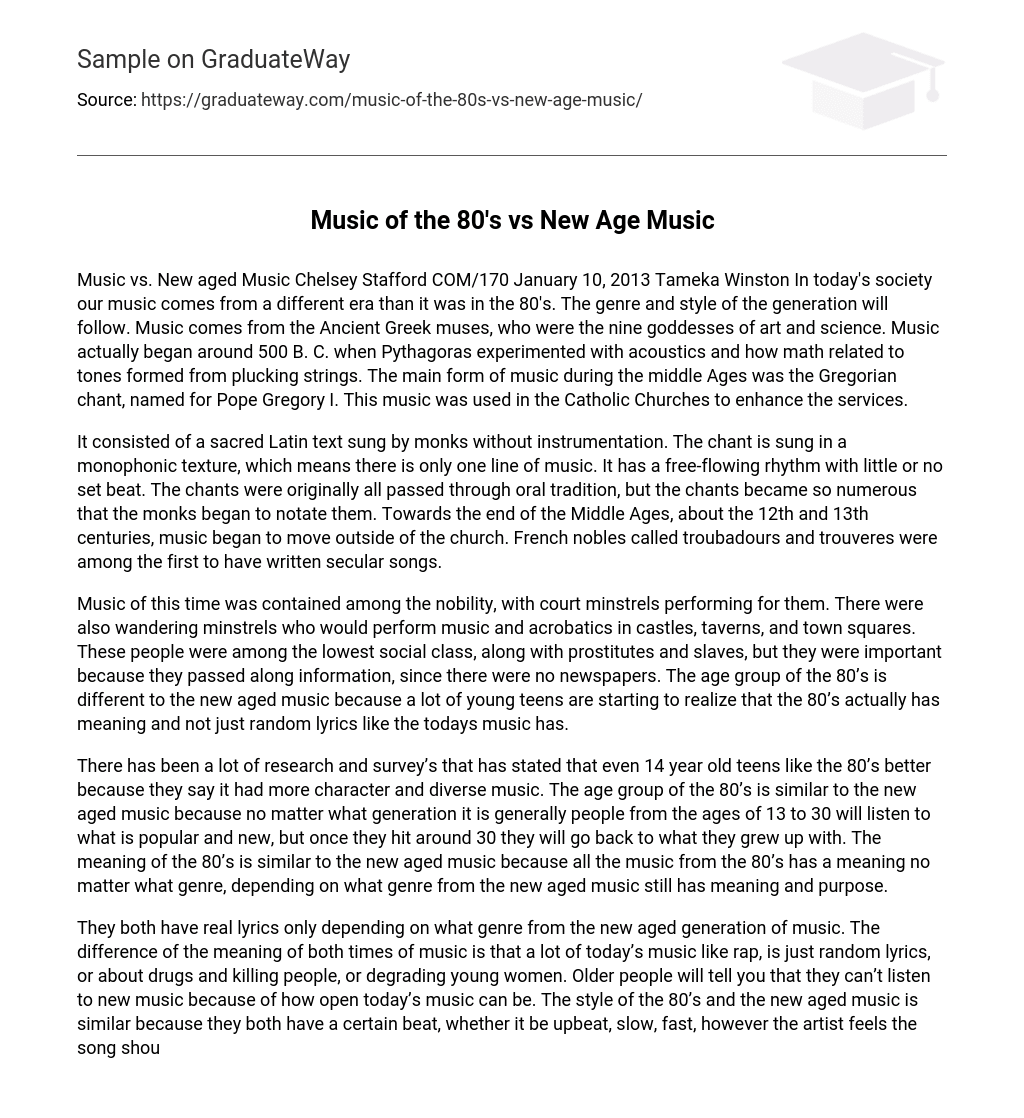Our contemporary music has diverged from the 80’s, reflecting the preferences and trends of today’s generation in terms of genre and style. The origins of music can be attributed to the Greek muses, a collective of nine goddesses linked to art and science. Approximately 500 B.C., Pythagoras performed scientific inquiries into acoustics, exploring the mathematical correlation between plucked string vibrations and musical tones. During medieval times, Gregorian chant prevailed as the primary form of music, named after Pope Gregory I. This particular musical style was utilized within Catholic Churches to enrich religious ceremonies.
The chants were initially transmitted orally, but as their quantity increased, the monks began to document them in writing. These chants consist of a sacred Latin text that is sung by monks without any musical instruments. The chant is performed in a monophonic texture, which means there is only one line of music, and it has a flowing rhythm with minimal or no predetermined beat.
As the Middle Ages neared its end, around the 12th and 13th centuries, music started to expand beyond religious settings. Among those leading the way in composing secular songs were French nobles known as troubadours and trouveres.
During this time period, the nobility were the primary audience for music and would be entertained by court minstrels. Additionally, there were wandering minstrels who performed music and acrobatics in various locations such as castles, taverns, and town squares. Despite being part of the lowest social class along with prostitutes and slaves, these performers played a vital role in spreading information since newspapers did not exist during that time. In contrast, 80s music has a different appeal as it resonates with a younger age group who are starting to realize its significance beyond mere random lyrics unlike contemporary music.
Research and surveys have shown that even 14-year-old teenagers prefer the 80’s era, believing it had more character and diverse music. The age group of the 80’s is comparable to the current generation, as individuals aged 13 to 30 tend to listen to popular and new music, but around the age of 30, they often return to the music they grew up with. The significance of the 80’s era parallels today’s music scene, as all genres from that time possessed meaning, similar to certain genres in contemporary music which still hold purpose and meaning.
Both genres of music from the new aged generation contain genuine lyrics, although the specific content may vary depending on the genre. The key difference between the two types of music lies in the conveyed meaning. Many contemporary songs, particularly in rap, consist of random lyrics or focus on topics such as drugs, violence, and disrespect towards young women. Consequently, older individuals often express their inability to appreciate modern music due to its explicit nature. However, both 80’s music and new aged music share a common use of specific rhythms that can be upbeat, slow, fast or any other way the artist intends to convey their song. These songs can evoke various emotions including sadness, anger, intensity revenge or even happiness.
Unlike the music of the 80’s, contemporary music takes a more progressive approach. In the past, certain ideas and expressions were considered offensive and could not be freely discussed without causing offense. However, society has become less sensitive to others’ words and actions, resulting in a diminished impact of such issues. Unlike the 80’s, today’s music incorporates subjects such as violence, sex, drugs, or demeaning young women as part of its acceptable content. The music from the 1980s served as a way to capture the prevailing events and atmosphere of that era.
The impact of 1980s musical genres on the music industry today is enduring. Although certain artists from that era still enjoy popularity, many have become relatively obscure except for television programs dedicated to reuniting bands and promoting musicians from that time period. This text delves into the influential role played by different bands and interests in shaping 80s music.
Hip-hop became dominant in the music charts in the first decade of the 21st century, a significant contrast to 50 years prior when black music was segregated to the “race” charts. One possible reason for the wide appeal of rap artists was their superior producers. In the latter half of the 20th century, popular and classical music had increasingly prioritized creating a soundscape and shaping the atmosphere rather than focusing on melody. Hip-hop continued this trend by largely disregarding melody and placing lyrics within a purely atmospheric context.
Hip-hop music places a greater emphasis on the role of the producer, who acts as both a sound director and sculptor. Consequently, there has been an increase in skilled producers due to the competitiveness of this genre. In terms of instrumental creativity, hip-hop producers surpass most rock producers. According to dictionaries and encyclopedias, music is defined as “an artistic form of auditory communication that utilizes instrumental or vocal tones in a structured and uninterrupted manner.” It is also described as “any pleasing and harmonious sound” created by singers or musical instruments (Source: wordnet.princeton.edu).
Music has numerous definitions that would require an entire book to explore thoroughly. Nevertheless, if there is a definitive explanation for music, it is this: music is both universal and subjective. What one person deems as music may not be the same for another. Even though 80’s and new school music have similarities and differences, they are both genres of music. Ultimately, we cannot fathom existence without music.
Works Cited
-
Essentials of Music. Sony Music Entertainment. 22 April 2002.





